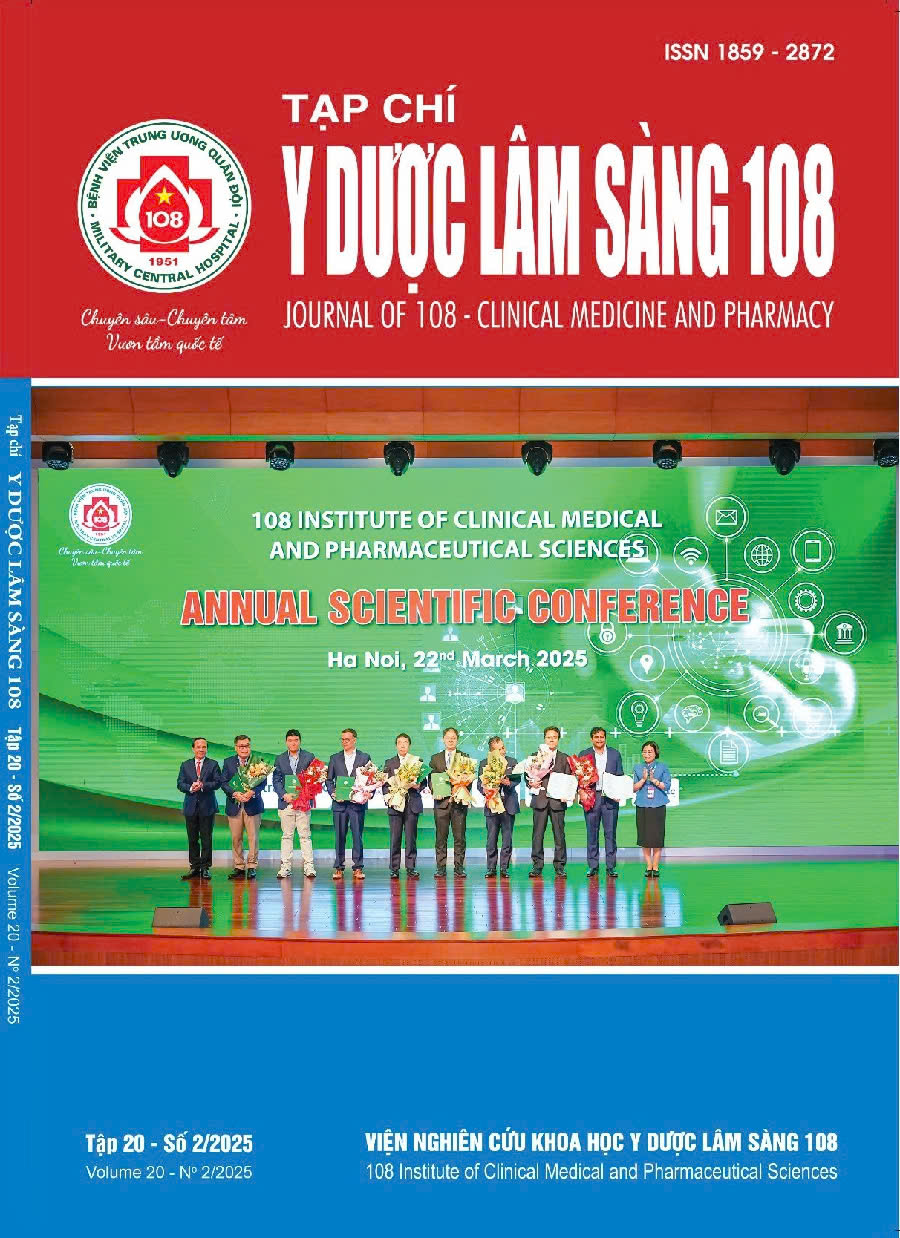Evaluation of effectiveness and the safety of ultrasound-guided mini-percutaneous nephrolithotomy without retrograde ureteral catheter placement
Main Article Content
Keywords
Abstract
Objective: Evaluation of effectiveness and the safety of ultrasound-guided mini-percutaneous nephrolithotomy without retrograde ureteral catheter placement for managing upper urinary tract calculi. Subject and method: A prospective cross-sectional study of 57 patients with renal and/or upper ureteral calculi who were treated by mini-percutaneous nephrolithotomy under ultrasound guidance without retrograde ureteral catheterization from January 2024 to June 2024 at 108 Military Central Hospital. Evaluation of the success rate of puncturing into renal calyx without retrograde ureteral placing at the first time; the rate of free-stone; complications; surgical time; and postoperative time. Result: The average age was 55.8 ± 13.9 (28 - 84). There were 40 (70.2%) male patients and 17 (29.8%) female patients. The average size of the stone was 21.7 ± 5.6mm. The renal pelvis dilatation grade I, II, III, and localized renal pelvis dilatation were 15 (26.3%), 36 (63.2%), 5 (8.8%), and 1 (1.8%) patients, respectively. The first successful puncture into calyx at the first time was in 55 (96.5%) patients. Using a basket to catch ureteral stones downstream were 3 (5.3%) patients. Ureteroscopy were 1 (1.8%) patients. Stone-free results were achieved in 53 (93.0%) patients. The average surgery time was 30.2 ± 5.6 minutes. The average hospital stay was 1.7 ± 0.9 days. Postoperative fever was observed in 4 (7.0%) patients, with no serious complications. Conclusion: Ultrasound-guided mini-percutaneous nephrolithotomy without ureteral catheterization is safe, effective, and shortens surgical and postoperative time. It is well indicated for renal and upper ureteral calculi cases with hydronephrosis.
Article Details
References
2. Goodwin WE, Casey WC and Woolf W (1955) Percutaneous trocar (needle) nephrostomy in hydronephrosis. JAMA 157(11): 891-894.
3. Florido C, Herren JL, Pandhi MB et al (2020) Emergent Percutaneous Nephrostomy for Pyonephrosis: A Primer for the On-Call Interventional Radiologist. Semin Intervent Radiol 37(1): 74-84.
4. Dyer RB, Regan JD, Kavanagh PV et al (2002) Percutaneous nephrostomy with extensions of the technique: step by step. Radiographics 22(3): 503-525.
5. Jamil MN, Haq FU, Islam EU et al (2022) Comparison Between Supine Position Versus Prone Position In Percutaneous Nephrolithotomy: A Single Centered Analysis Of 623 Cases. J Ayub Med Coll Abbottabad 34(Suppl 1)(4):S1003-S1007.
6. Proietti S, Rodríguez-Socarrás ME, Eisner B et al (2019) Supine percutaneous nephrolithotomy: tips and tricks. Transl Androl Urol 8(4):S381-S388.
7. Simayi A, Tayier T, Aimaier A et al (2023) Ultrasound-guided mini-percutaneous nephrolithotomy in the treatment of upper urinary tract stones in children: A single-center evaluation. Asian J Surg 46(1): 1-5.
8. Chen W, Shi Z, Feng J et al (2023) Effects of severe hydronephrosis on surgical outcomes of minimally invasive percutaneous nephrolithotomy (MPCNL). Wideochir Inne Tech Maloinwazyjne 18(2): 328-342.
9. Zhang X, Zhu Z, Shen D et al (2022) Ultrasound-guided percutaneous nephrolithotomy without indwelling ureteral catheter in older adults with upper urinary calculi: A retrospective study. Medicine (Baltimore) 101(43): 31285.
10. Peng C, Chen Z, Xu J et al (2021) Risk factors for urinary infection after retrograde upper urinary lithotripsy: Implication for nursing. Medicine (Baltimore); 100(31):e26172.
11. Akbulut F, Ucpinar B, Savun M et al (2015) A Major Complication in Micropercutaneous Nephrolithotomy: Upper Calyceal Perforation with Extrarenal Migration of Stone Fragments due to Increased Intrarenal Pelvic Pressure. Case Rep Urol: 792780.
12. Erkoc M, Bozkurt M, Danis E et al (2022) Comparison of mini-PCNL and retrograde intrarenal surgery in the treatment of kidney stones over 50-year-old patients. Urologia 89(4): 575-579.
 ISSN: 1859 - 2872
ISSN: 1859 - 2872
